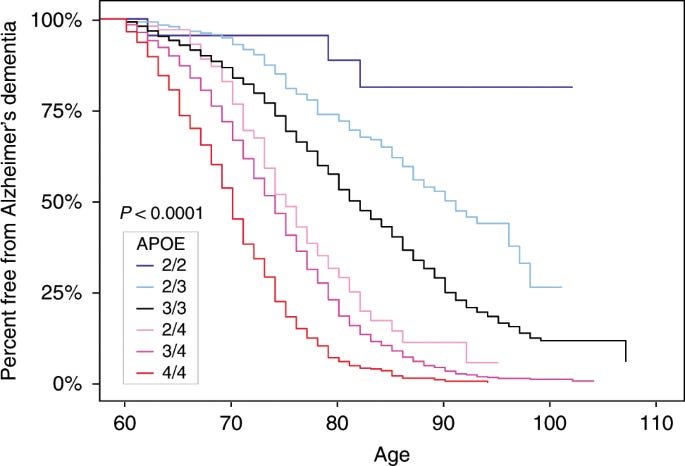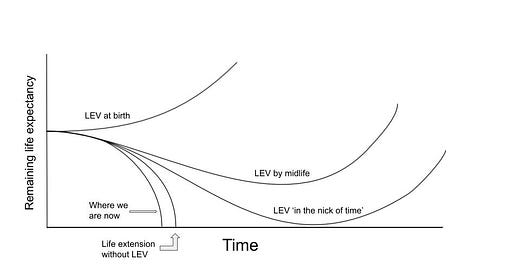How Do We Engineer Biological Immortality?
Extending maximum human lifespan requires advanced bioengineering.
Introduction
To start, I will say that this article will not be too scientific. I won’t be making references to any literature. What is to come will be my current and somewhat uninformed opinion, which I am open to changing if presented with persuasive evidence to the contrary.
Before I start delving into papers which demonstrate the recent progress humanity has made towards biological immortality, I need to talk about what this newsletter will be all about, and what it won’t be about.
A Brief Aside on the Importance of Urgency
First things first. Biological immortality is not inevitable. Technological progress in any field requires mobilised, focussed, high-efficiency effort driven by maniacal urgency and ruthless dedication to the cause.
Just as Elon mobilised humanity’s mechanical engineers and rocket scientists on a mission to mass produce reusable rockets, someone else needs to mobilise humanity’s biomedical researchers, synthetic biologists and nano/computational technologists to design and engineer humans with lifespan-extending and information-preserving cellular machinery.
We cannot take scientific and technological progress for granted. The wheel of progress spins ever faster only in the directions we focus it. And compounding growth curves only occur in the burgeoning technology stacks that our brightest minds work tirelessly to accelerate.
The natural progression of an advanced society is in the direction of stagnation and bureaucracy. As Isaac Asimov described in his science fiction novel Foundation, any sufficiently advanced empire is destined to collapse. Our Western Empire, which values individuality and scientific progress, like many historical empires, is also likely to fall. As empires age, they become increasingly difficult to govern efficiently. Bureaucratic inertia leads to poor decision-making machinery, inefficient capital allocation and barriers to innovation.
Every empire thus far has reached a technological peak, and eventually regressed. Over time, scientific knowledge is lost as a collapsing society focusses on maintaining the status quo rather than encouraging advancement. As we weaken, rival powers and internal factions gain influence, culture stagnates, infrastructure decays, the social order collapses and hard-won scientific and technological progress is lost.
This is all to say, we are not living at the end of history, and we don’t have time to waste. The world order is changing, and the American Empire is in the early stages of its collapse. I really hope this doesn’t happen. I hope Marc Andreessen is right. I hope America wins. But we cannot deny that these awesome exponential growth trends across multiple complementary and converging technologies may not last forever.
Longevity Escape Velocity and the Technologies That Matter
In order to make humanity an immortal and disease-free species, we need to reach what Aubrey de Grey has coined “Longevity Escape Velocity” before it’s too late.
Longevity escape velocity is the event horizon of the lifespan singularity. There will come a time when your remaining life expectancy is extended at a faster rate than the time that is passing. In other words, breakthroughs in biotech and longevity research will extend our remaining lifespan, buying more time for further breakthroughs, which, for some people, will eventually yield a J-curve in remaining lifespan.
Depending on your age and risk factors, you have a higher or lower likelihood of achieving escape velocity compared to others. Each of you reading this will need to wait for a different maturity level of biotechnology before you will reach your personal escape velocity. Biological aging (disease manifestations and mortality risk) increases exponentially with time. If you’re older and metabolically unwell, then you will require a dramatically higher rate of progress before you can be confident that you will not die from age-related diseases.
If we are the first generation experiencing substantial increases in lifespan, it is also true that some of us might have to die for the next generation to figure out what went wrong. Biological immortality is not yet close to being an inevitability for any one individual; but on a population scale, we have a chance.
I believe that humanity will reach longevity escape velocity within our lifetimes due to converging exponential growth trends in (1) synthetic biology, (2) machine learning, (3) quantum computing, (4) genetic engineering, and (5) organism-wide gene delivery technology.
I will be publishing several articles on each of these fields in the coming weeks and months, so I won’t go into details now. But by this time next year, I hope we will have learned a great deal together about the science underpinning these revolutionary technologies, and will have some ideas on how we might use this emerging biological ‘tech stack’ in our quest for eternal youth.
What Engineering Immortality Will Not Be About
Now that we have a roadmap, let’s briefly touch on everything I will not be talking about.
Metabolic engineering: Increasing average human lifespan by reversing metabolic syndrome (including insulin resistance, NAFLD, cardiovascular disease, etc.)
Metabolic engineering will soon help us all live healthier, slightly longer and more productive lives. It’s what I’m working on right now. It’s longevity adjacent and I’m all for it. But it is a local maxima in the longevity landscape, and progress here is unlikely to translate into progress towards the global maximum of lifespan extension. That being said, the opportunity here is likely to be $1T+. And if you are (or know) someone with expertise in biotech, medicinal chemistry, drug development, clinical trials, biotech operations, computational biology, cell-based assays or are just super interested in this field, please reach out to me. The world’s first biotech startup that builds a real metabolic engineering drug to compete with big pharma will eventually reach a market cap bigger than Apple. And if this company is led by longevity mission-aligned founders who refuse to sell their drug to one of the four big biopharma companies, then these founders will have an gargantuan amount of capital they can deploy to fund moonshot longevity projects. We’re talking $100b+ real moonshots to solve bottlenecks in longevity science.Biostasis: Cryogenically preserving humans at very low temperatures after death with the hope that future medical technology might revive and treat them.
Don’t get me wrong. I recently signed up to the Alcor Life Extension Foundation in hopes that if I legally die, my corpse and brain will be vitrified in liquid nitrogen. But this is a fail-safe. It relies on humanity achieving longevity escape velocity, and then achieving a completely different revival tech stack secondary to this. It then relies on future humans actually deciding to revive you, not just for a fun experiment but because they believe they are morally required to. Bringing people back from the dead just because you can is not an obvious moral conclusion of a sophisticated future society. It relies on the continued hegemony of both Western civilisation as well as the organisations (Alcor Foundation, Cryonics Institute, Tomorrow Bio, etc) that currently house and maintain the vitrified. It requires that future humans respect your decision to vitrify yourself and to take it upon themselves to bring you back to good health, restore your right and liberties, etc. There is no reason to have faith in all of these independent events lining up perfectly. Cryogenic preservation gives people who are longevity adjacent but not truly committed an excuse to keep doing what they are doing (a.k.a. working in tech and finance). I’m still going to get frozen if I die, and I recommend it for you as well. But this isn’t the answer.
Replacement: Growing non-sentient human clones for organ transplants and full-body replacement.
Again, I’m all for this. I really want someone to do it. In fact, I know some people who are working on it, and who are currently raising $30m for this project (reach out to me if you’d like to be connected). But the sociolegal landscape surrounding this field is fraught with challenges. Societal acceptance is not guaranteed. The legal precedent upon which this sits is far from solid. The US Supreme Court is likely to lean conservative for at least the next decade. If the general public can’t reach consensus on the issue of abortion and IVF, then they are very unlikely to reach consensus on growing non-sentient clones for organ harvesting. Manufacturing synthetic organs from induced pluripotent stem cells (iPSCs) is likely to face much less public backlash. But even if we were able to replace all of our visceral organs, the vast majority of humans will develop Alzheimer’s disease by age 120.
Percentage of humans free from Alzheimer’s dementia stratified based on APOE genotype, a gene that codes for a protein that transports cholesterol and fats in the blood. Some APOE variants put people at more risk of both cardiovascular disease and Alzheimer’s disease than others. Humans homozygous for APOE2 have an exceptionally low likelihood of developing Alzheimer’s dementia during their expected lifespan, however most people in this low-risk population would eventually develop the disease if they lived to see their 120th birthday. (Reiman et al., 2020) That remains a glass ceiling on our life expectancy. We would still need to replace/preserve the human brain, which is complicated by the fact that the brain is the location from which our consciousness emerges and also by the fact that we don’t really know what consciousness is. That being said, the organ shortage is very real. If we can eliminate wait-times for organ transplants by growing perfectly compatible organs from your own iPSCs, then we will save millions of lives every year. And if we can eliminate the organ supply problem, then we can also grow immune-compatible tissues for elective purposes – to replace the aging parts of our bodies well before transitions to disease states. But replacement is not something I will be focussing on in this newsletter.
All Roads Lead Back to Advanced Bioengineering
The root cause of both aging and cancer is entropy. And this primarily manifests as genomic and epigenomic information loss that accumulates over the course of a human lifespan (Alan Tomusiak has a brilliant article on this here).
For either replacement, biostasis or metabolic drugs to enable biological immortality, humans eventually need to engineer therapeutics that can prevent and reverse the entropic decay of large organisms at the molecular and cellular level.
This requires advanced bioengineering, from therapeutic-grade genome engineering techniques and quantum modelling of human cells, to genome-length DNA synthesis and more accurate in-silico protein design.
As a society, we should focus most of our efforts on using advanced bioengineering to design enhanced/optimised cellular machinery that can better preserve genomic and epigenomic information at the cellular and molecular level against entropic disorganisation. This is the path toward biological immortality. It’s a fight against the second law of thermodynamics. And it requires cellular machinery that operates with higher fidelity than the primitive versions that evolution has blessed us with. This is Engineering Immortality.
See you next week.
Acknowledgements
Thank you to Robert Langer, Alan Tomusiak, Michael Florea and Alec Reiss for reviewing drafts of this article.




